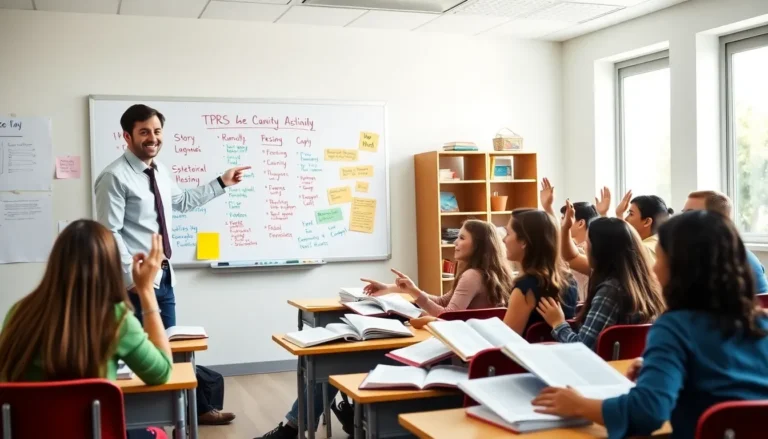Table of Contents
ToggleCultural expressions are the vibrant threads that weave together the rich tapestry of human experience. From the rhythmic beats of a traditional dance to the tantalizing flavors of regional cuisine, these expressions reflect the heart and soul of communities around the globe. They’re not just art; they’re the stories, beliefs, and values that shape who we are.
Imagine a world without the colorful festivals, the captivating folklore, or the diverse languages that spice up our conversations. It’d be like a pizza without toppings—bland and lacking character. Cultural expressions invite us to celebrate our differences while reminding us of our shared humanity. So buckle up as we dive into this fascinating exploration of how these expressions influence our lives, foster connections, and keep the world spinning with creativity and joy.
Understanding Cultural Expressions
Cultural expressions shape human interactions and experiences in profound ways. They embody the essence of communities, reflecting values, beliefs, and shared histories.
Definition and Importance
Cultural expressions represent the creative output of a community. They encompass art, music, dance, and literature, among others. Such forms serve as a medium for conveying ideas and emotions. Engaging with these expressions fosters empathy and understanding. They provide insight into different cultural backgrounds and enhance communication between diverse groups. Recognizing their importance aids in preserving cultural heritage and promoting inclusivity. Ultimately, cultural expressions enrich personal experiences, encouraging a deeper appreciation for human creativity.
Forms of Cultural Expressions
Cultural expressions manifest in various forms. Visual art captures emotions through paintings and sculptures. Music transcends language barriers, offering joy across continents. Traditional dance showcases histories and customs unique to specific communities. Culinary practices reflect cultural identities through flavors and techniques. Storytelling preserves memories and teaches morals across generations. All these forms contribute to a vibrant cultural landscape. Together, they create a tapestry of human experience that celebrates both individuality and commonality.
Historical Context of Cultural Expressions
Cultural expressions have evolved significantly throughout history, reflecting societal changes and technological advancements. These expressions showcase the creativity and resilience of communities across time.
Evolution Through Time
Cultural expressions transformed as societies evolved. Early art forms, like rock paintings, illustrate humanity’s first attempts to communicate and share experiences. Later, civilizations developed intricate art styles and practices that mirrored cultural values and advancements. The Renaissance marked a pivotal moment, introducing a focus on humanism and individual expression in art and literature. Modern technology further revolutionized cultural expressions, enabling global sharing through film and digital media. Each period brought innovation, resulting in a rich tapestry of expressive forms.
Influences of Major Events
Major historical events have profoundly shaped cultural expressions. Wars and revolutions often spur artistic movements that challenge the status quo. The Harlem Renaissance drew inspiration from the African American experience, emphasizing cultural identity through various art forms. Social movements, like the civil rights movement, also influenced music and literature, conveying messages of hope and resistance. Additionally, globalization connected cultural expressions worldwide, leading to hybrid forms and shared artistic practices. Each event fueled creativity, leaving lasting impacts that continue to resonate today.
Contemporary Cultural Expressions
Contemporary cultural expressions reflect evolving values and diverse perspectives within societies. These expressions thrive in various forms, including art, literature, music, and performance.
Art and Literature
Visual art plays a central role in contemporary expressions. Artists use mediums such as painting, sculpture, and digital installations to convey current issues, emotions, and identities. Literature also adapts to modern experiences, with authors exploring themes like migration, identity, and environmental concerns. Novelists and poets share narratives that capture the essence of contemporary life, often weaving personal experiences with broader societal reflections. Both art and literature serve as powerful tools for social commentary, stimulating dialogue about pressing issues and inspiring change.
Music and Performance
Music in today’s society integrates various genres and styles. Artists blend traditional sounds with contemporary influences, resulting in unique sonic landscapes. Live performances become immersive experiences, often incorporating elements like visual projections and audience interaction. Dance forms also adapt, showcasing inventive choreography that reflects current cultural attitudes. Musicians and performers engage their audiences, encouraging participation and fostering community. The accessibility of global music platforms amplifies diverse voices, promoting cross-cultural collaborations that enrich the overall artistic environment.
Cultural Expressions Around the World
Cultural expressions reveal the rich tapestry of human experience, varying significantly across regions and communities.
Regional Variations
Artistic styles differ globally, influenced by local traditions and histories. Cultural expressions in Africa often emphasize communal values through vibrant textiles and percussion music. In Asia, calligraphy and poetry reflect deep philosophical roots, while indigenous cultures in the Americas showcase storytelling through oral traditions and crafts. Europe’s art movements, such as Impressionism and Surrealism, highlight individual perspectives and emotions. Each region presents unique practices, contributing to the diversity of global expressions that enrich our understanding of humanity.
Globalization and Cultural Exchange
Globalization transforms cultural expressions, fostering interaction among diverse communities. Artistic collaborations now blend traditional elements with modern influences, creating hybrid forms. Musicians often merge local sounds with international genres, resulting in fresh, innovative compositions. Platforms like social media enable artists to share their work widely, breaking geographical barriers. This exchange encourages the preservation of cultural heritage while embracing new ideas. As a result, the global artistic landscape constantly evolves, reflecting a shared humanity through varied and interconnected expressions.
The Role of Technology in Cultural Expressions
Technology significantly influences cultural expressions, providing new ways for communities to share their creativity. Digital advancements open pathways for diverse voices, allowing for broader representation in the arts.
Digital Platforms and Accessibility
Digital platforms enhance accessibility, enabling artists to reach global audiences. Social media networks like Instagram and YouTube allow them to showcase their work instantly. These platforms foster engagement, connecting creators with fans across borders. Increased visibility enables artists from underrepresented backgrounds to gain recognition. Furthermore, these platforms provide tools for collaboration, merging various cultural elements that enrich artistic outputs. Online galleries and streaming services facilitate access to a wide array of cultural expressions, inviting exploration and learning.
Impact on Traditional Practices
Technology reshapes traditional practices, merging old methods with modern techniques. Artisans often incorporate digital tools into traditional crafts, creating innovative results. For example, printmaking now frequently uses digital imagery to enhance designs. Musicians explore new production techniques, leading to unique sounds that blend genres. Traditional storytelling adapts, using multimedia formats to engage younger audiences. Educators use technology to teach cultural heritage, preserving knowledge while embracing modernity. Hybrid expressions emerge, reflecting cultural evolution while respecting historical roots. Technology plays a crucial role in revitalizing traditions, ensuring their relevance in contemporary society.
Cultural expressions are vital to understanding the rich tapestry of human experience. They serve as powerful tools for connection and empathy while reflecting the diverse values and histories of communities. As these expressions continue to evolve alongside societal changes and technological advancements, they foster a sense of shared humanity that transcends geographical boundaries.
Engaging with various forms of cultural expression not only enriches individual lives but also strengthens the fabric of society. By celebrating and preserving these creative outputs, people can appreciate the beauty in both differences and commonalities, fostering a more inclusive world. The journey through cultural expressions is ongoing, inviting everyone to explore and embrace the myriad ways in which creativity shapes human existence.







